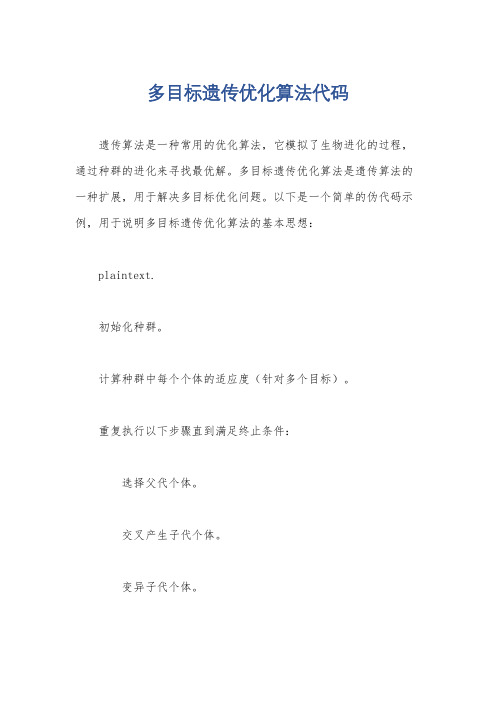多目标遗传算法
多目标遗传算法NSGA-II

在NSGA-II中,我们计算两个属性Sp 和np来帮助我们识别更好的个体。
快速非支配排序
假设种群大小为P,该算法需要计算每个个体p的被支配个数np和该个体支配的解的集合Sp 这两个参数。 遍历整个种群
该算法的伪代码如下:
拥挤度
• 为了使得到的解在目标空间中更加均匀,引入了拥挤度的概念
•为所有个体的拥挤距离初始化零。 •审视所有的个人和目标值。通过用Inf值分配绑定解决方案 来选择它们。 •计算每个目标的第m个最大值和最小值,得到归一化的分 母。 •对第i个个体的m个目标的拥挤距离求和
计算拥挤度是为了保存下来相似程度较低的解,保持解空间的多样性
精英保留策略
1 首先将父代种群Pt和子代种群Qt合成种群Rt 2 根据以下规则从种群Rt生成新的父代种群Rt+1
(1)根据Pareto等级从低到高的顺序,将整层种 群放入父代种群Rt+1中,真到某一层个体不能 全部放入父代种群Rt+1。 (2)将该层个体根据拥挤度从大到小排列,依次 放入父代种群Rt+1中,直到父代种群Rt+1f填满。
单目标优化——》多目标优化
NSGA-II 在常规遗传算法上的改进
• 1 快速非支配算子设计 • 多目标优化问题的设计关键在于求取Pareto最优解集。
• 2 通过优先选择拥挤距离较大的个体
• 3 精英策略选择算子
• NAS中的性能评估也可以是一个多目标问题 • 测试集上的准确率 • 参数数量
遗传算法解决多目标优化问题
多目标优化问题:
• 包含多个可能有冲突的目标函数
NSGA-Ⅱ算法,即带有精英保留策略的快 速非支配多目标优化算法,是一种基于 Pareto最优解的多目标优化算法。
邻域培植多目标遗传算法ncga简介

邻域培植多目标遗传算法ncga简介邻域培植多目标遗传算法(NCga)是一种用于解决多目标优化问题的进化算法。
与传统的单目标遗传算法不同,多目标遗传算法旨在寻找一组解,这组解中每个解都是最优解的其中之一,而不是一个单一的最优解。
NCga算法是多目标遗传算法的一种改进版本,它主要解决了传统多目标遗传算法在收敛速度和解的多样性方面的不足。
NCga算法的主要特点包括以下几个方面:1. 遗传算法的基本原理:NCga算法是基于遗传算法的基本原理设计的,包括选择、交叉、变异等基本操作。
遗传算法通过模拟生物进化的过程,不断优化种群中的个体,逐步接近最优解。
2. 邻域培植策略:NCga算法引入了邻域培植策略,通过在当前种群中选择最优解的邻域解来更新种群,以提高种群的多样性和全局搜索能力。
3. 多目标优化:NCga算法可以同时优化多个目标函数,找到一组解,这组解中每个解都是最优解的其中之一。
通过多目标优化,NCga算法可以在不同的目标之间找到平衡,得到更加全面的解集。
4. 收敛速度和解的多样性:NCga算法通过邻域培植策略,可以加速算法的收敛速度,同时保持解的多样性,避免陷入局部最优解。
5. 适用范围:NCga算法适用于各种多目标优化问题,包括工程优化、组合优化、调度问题等。
通过调整算法的参数和优化策略,可以灵活应用于不同的问题领域。
总的来说,邻域培植多目标遗传算法(NCga)是一种有效的多目标优化算法,通过结合遗传算法的基本原理和邻域培植策略,可以有效解决多目标优化问题,具有收敛速度快、解的多样性高的优点,适用于各种多目标优化问题的求解。
NCga算法在实际问题中具有广泛的应用前景,可以帮助优化问题的求解,提高问题的解的质量和效率。
多目标遗传优化算法代码

多目标遗传优化算法代码
遗传算法是一种常用的优化算法,它模拟了生物进化的过程,通过种群的进化来寻找最优解。
多目标遗传优化算法是遗传算法的一种扩展,用于解决多目标优化问题。
以下是一个简单的伪代码示例,用于说明多目标遗传优化算法的基本思想:
plaintext.
初始化种群。
计算种群中每个个体的适应度(针对多个目标)。
重复执行以下步骤直到满足终止条件:
选择父代个体。
交叉产生子代个体。
变异子代个体。
计算子代个体的适应度(针对多个目标)。
更新种群。
在实际编写多目标遗传优化算法的代码时,需要根据具体的问
题定义适应度函数、选择算子、交叉算子和变异算子等。
此外,还
需要考虑种群大小、迭代次数、交叉概率、变异概率等参数的设置。
对于具体的实现代码,可以使用Python、Java、C++等编程语
言来编写。
在实际编写代码时,需要根据具体的问题进行适当的调
整和优化,以获得更好的求解效果。
总的来说,多目标遗传优化算法是一种强大的优化工具,可以
用于解决多目标优化问题,但在实际应用中需要根据具体的问题进
行适当的调整和优化。
希望这个简单的伪代码示例能够帮助你理解
多目标遗传优化算法的基本思想。
多目标遗传算法里面的专业名词

多目标遗传算法里面的专业名词1.多目标优化问题(Multi-Objective Optimization Problem, MOP):是指优化问题具有多个相互冲突的目标函数,需要在不同目标之间找到平衡和妥协的解决方案。
2. Pareto最优解(Pareto Optimal Solution):指对于多目标优化问题,一个解被称为Pareto最优解,如果不存在其他解能在所有目标上取得更好的结果而不使得任何一个目标的结果变差。
3. Pareto最优集(Pareto Optimal Set):是指所有Pareto最优解的集合,也称为Pareto前沿(Pareto Front)。
4.个体(Domain):在遗传算法中,个体通常表示为一个潜在解决问题的候选方案。
在多目标遗传算法中,每个个体会被赋予多个目标值。
5.非支配排序(Non-Dominated Sorting):是多目标遗传算法中一种常用的个体排序方法,该方法将个体根据其在多个目标空间内的优劣程度进行排序。
6.多目标遗传算法(Multi-Objective Genetic Algorithm, MOGA):是一种专门用于解决多目标优化问题的遗传算法。
它通过模拟生物遗传和进化的过程,不断地进化种群中的个体,以便找到多个目标下的最优解。
7.多目标优化(Multi-Objective Optimization):是指优化问题具有多个目标函数或者多个约束条件,需要在各个目标之间取得平衡,找到最优的解决方案。
8.自适应权重法(Adaptive Weighting):是一种多目标遗传算法中常用的方法,用于动态调整不同目标之间的权重,以便在不同的阶段能够更好地搜索到Pareto前沿的解。
9.支配关系(Dominance Relation):在多目标优化问题中,一个解支配另一个解,指的是在所有目标上都至少不差于另一个解,并且在某个目标上能取得更好的结果。
多目标优化方法及实例解析

多目标优化方法及实例解析常用的多目标优化方法包括遗传算法、粒子群算法、模拟退火算法等,下面将对这几种方法进行简要介绍,并给出实例解析。
1. 遗传算法(Genetic Algorithm, GA)是模拟生物遗传和进化过程的一种优化算法。
它通过设计合适的编码、选择、交叉和变异等操作,模拟自然界中的遗传过程,逐步问题的最优解。
遗传算法的优点是可以同时处理多个目标函数,并能够在计算中保留多个候选解,以提高效率。
实例解析:考虑一个旅行商问题(Traveling Salesman Problem, TSP),即在给定的城市之间寻找一条最短的路径,使得每个城市只访问一次。
在多目标优化中,可以同时优化总路径长度和访问城市的次序。
通过遗传算法,可以设计合适的编码方式来表示路径,选择合适的交叉和变异操作,通过不断迭代,找到一组较优的解。
2. 粒子群算法(Particle Swarm Optimization, PSO)是一种模拟鸟群觅食行为的优化算法。
算法中的每个粒子表示一个候选解,在过程中通过学习其他粒子的经验和自身的历史最优值,不断调整自身位置和速度,最终找到一组较优的解。
粒子群算法的优点是收敛速度快,效果较好。
实例解析:考虑一个机器学习中的特征选择问题,即从给定的特征集合中选择一组最优的特征子集。
在多目标优化中,可以同时优化特征子集的分类准确率和特征数量。
通过粒子群算法,可以将每个粒子表示一个特征子集,通过学习其他粒子的经验和自身的历史最优值,不断调整特征子集的组成,最终找到一组既具有较高分类准确率又具有合适特征数量的特征子集。
3. 模拟退火算法(Simulated Annealing, SA)是模拟固体退火过程的一种优化算法。
算法通过模拟固体在高温下的松弛过程,逐渐降低温度,使固体逐渐达到稳定状态,从而最优解。
模拟退火算法的优点是能够跳出局部最优解,有较好的全局性能。
实例解析:考虑一个布局优化问题,即在给定的区域内摆放多个物体,使得物体之间的互相遮挡最小。
多目标多约束优化问题算法

多目标多约束优化问题算法多目标多约束优化问题是一类复杂的问题,需要使用特殊设计的算法来解决。
以下是一些常用于解决这类问题的算法:1. 多目标遗传算法(Multi-Objective Genetic Algorithm, MOGA):-原理:使用遗传算法的思想,通过进化的方式寻找最优解。
针对多目标问题,采用Pareto 前沿的概念来评价解的优劣。
-特点:能够同时优化多个目标函数,通过维护一组非支配解来表示可能的最优解。
2. 多目标粒子群优化算法(Multi-Objective Particle Swarm Optimization, MOPSO):-原理:基于群体智能的思想,通过模拟鸟群或鱼群的行为,粒子在解空间中搜索最优解。
-特点:能够在解空间中较好地探索多个目标函数的Pareto 前沿。
3. 多目标差分进化算法(Multi-Objective Differential Evolution, MODE):-原理:差分进化算法的变种,通过引入差分向量来生成新的解,并利用Pareto 前沿来指导搜索过程。
-特点:对于高维、非线性、非凸优化问题有较好的性能。
4. 多目标蚁群算法(Multi-Objective Ant Colony Optimization, MOACO):-原理:基于蚁群算法,模拟蚂蚁在搜索食物时的行为,通过信息素的传递来实现全局搜索和局部搜索。
-特点:在处理多目标问题时,采用Pareto 前沿来评估解的质量。
5. 多目标模拟退火算法(Multi-Objective Simulated Annealing, MOSA):-原理:模拟退火算法的变种,通过模拟金属退火的过程,在解空间中逐渐减小温度来搜索最优解。
-特点:能够在搜索过程中以一定的概率接受比当前解更差的解,避免陷入局部最优解。
这些算法在解决多目标多约束优化问题时具有一定的优势,但选择合适的算法还取决于具体问题的性质和约束条件。
遗传算法学习--多目标优化中的遗传算法
遗传算法学习--多⽬标优化中的遗传算法在⼯程运⽤中,经常是多准则和对⽬标的进⾏择优设计。
解决含多⽬标和多约束的优化问题称为:多⽬标优化问题。
经常,这些⽬标之间都是相互冲突的。
如投资中的本⾦最少,收益最好,风险最⼩~~多⽬标优化问题的⼀般数学模型可描述为:Pareto最优解(Pareto Optimal Solution)使⽤遗传算法进⾏求解Pareto最优解:权重系数变换法:并列选择法:基本思想:将种群全体按⼦⽬标函数的数⽬等分为⼦群体,对每⼀个⼦群体分配⼀个⽬标函数,进⾏择优选择,各⾃选择出适应度⾼的个体组成⼀个新的⼦群体,然后将所有这些⼦群体合并成⼀个完整的群体,在这个群体⾥进⾏交叉变异操作,⽣成下⼀代完整群体,如此循环,最终⽣成Pareto最优解。
如下图:排列选择法:基于Pareto最优个体的前提上,对群体中的各个个体进⾏排序,依据排序进⾏选择,从⽽使拍在前⾯的Pareto最优个体将有更⼤的可能性进⼊下⼀代群体中。
共享函数法:利⽤⼩⽣境遗传算法的技术。
算法对相同个体或类似个体是数⽬加⼀限制,以便能够产⽣出种类较多的不同的最优解。
对于⼀个个体X,在它的附近还存在有多少种、多⼤程度相似的个体,是可以度量的,这种度量值称为⼩⽣境数。
计算⽅法:s(d)为共享函数,它是个体之间距离d的单调递减函数。
d(X,Y)为个体X,Y之间的海明距离。
在计算出⼩⽣境数后,可以是⼩⽣境数较⼩的个体能够有更多的机会被选中,遗传到下⼀代群体中,即相似程度较⼩的个体能够有更多的机会被遗传到下⼀代群体中。
解决了多⽬标最优化问题中,使解能够尽可能的分散在整个Pareto最优解集合内,⽽不是集中在其Pareto最优解集合内的某⼀个较⼩的区域上的问题。
混合法:1. 并列选择过程:按所求多⽬标优化问题的⼦⽬标函数的个数,将整个群体均分为⼀些⼦群体,各个⼦⽬标函数在相应的⼦群体中产⽣其下⼀代⼦群体。
2. 保留Pareto最优个体过程:对于⼦群体中的Pareto最优个体,不让其参与个体的交叉和变异运算,⽽是直接保留到下⼀代⼦群体中。
复杂多目标问题的优化方法及应用
复杂多目标问题的优化方法及应用一、前言复杂多目标问题是指在优化过程中存在多个目标函数,这些目标函数之间可能存在冲突或矛盾,因此需要寻找一种合适的方法来解决这类问题。
本文将介绍复杂多目标问题的优化方法及应用。
二、复杂多目标问题的优化方法1. 多目标遗传算法(MOGA)多目标遗传算法是一种常用的优化方法,它基于遗传算法,并通过引入多个适应度函数来解决多目标问题。
MOGA 通过保留 Pareto 前沿(Pareto front)上的解来实现优化。
Pareto 前沿是指无法再找到更好的解决方案,同时保证了所有目标函数都得到了最佳优化。
2. 多目标粒子群算法(MOPSO)多目标粒子群算法也是一种常用的优化方法,它基于粒子群算法,并通过引入多个适应度函数来解决多目标问题。
MOPSO 通过维护一个Pareto 最优集合来实现优化。
Pareto 最优集合是指所有非支配解构成的集合。
3. 多目标差分进化算法(MODE)差分进化算法是一种全局搜索算法,它通过不断地更新种群的参数来寻找最优解。
MODE 是一种基于差分进化算法的多目标优化方法,它通过引入多个适应度函数来解决多目标问题。
MODE 通过维护一个Pareto 最优集合来实现优化。
4. 多目标蚁群算法(MOTA)蚁群算法是一种模拟自然界中蚂蚁寻找食物的行为的算法,它通过不断地更新信息素来寻找最优解。
MOTA 是一种基于蚁群算法的多目标优化方法,它通过引入多个适应度函数来解决多目标问题。
MOTA 通过维护一个 Pareto 最优集合来实现优化。
三、复杂多目标问题的应用1. 工程设计在工程设计中,往往需要考虑多个因素,如成本、效率、可靠性等。
使用复杂多目标问题的优化方法可以帮助工程师在保证各项指标达到要求的情况下,尽可能地减少成本或提高效率。
2. 市场营销在市场营销中,往往需要同时考虑销售额、市场份额和品牌知名度等指标。
使用复杂多目标问题的优化方法可以帮助企业在提高销售额的同时,尽可能地提高市场份额和品牌知名度。
多目标遗传算法
多目标遗传算法
多目标遗传算法(Multi-Objective Genetic Algorithm, MOGA)是一种模拟自然进化的建模方法,被广泛应用于解决复杂的优化优化问题,特别是多目标优化问题。
此算法类似于遗传算法,它利用遗传演化算法和对抗性进化算法来搜索和优化不同的目标。
MOGA借鉴了生物学中心脏进化理论,以及模拟自然进化的思想,并用于解决复杂的多目标优化问题。
MOGA在多目标优化中的主要思想是在一个全局搜索空间中调节和优化目标变量之间的权衡关系,而不是在单个搜索空间中调节和优化它们。
MOGA将搜索空间划分为多个子空间,每个子空间由一组相关的变量组成,它们分别定义了多个有限目标函数。
MOGA使用多种搜索方法,如进化策略分箱搜索(ESE)、贪婪搜索(FST)以及地图网络搜索(MCS)来搜索每个子空间,以找出优化结果。
特别是,MOGA针对复杂的多目标优化问题提出了一种多层次优化方法。
这在很大程度上减少了传统搜索空间中搜索的计算成本,并改善了算法的可缩放性。
MOGA还结合使用了不同的使用了不同的技术来改进算法,从而提高搜索效率和储备越来越多的优化解决方案。
MOGA在互联网领域极具应用价值,如在多样化内容发布中,MOGA可以帮助互联网公司优化及管理用户的体验。
MOGA还可用于优化网络的资源分配,已让网络资源得到有效的利用,从而提高网络的处理效率。
此外,MOGA还可用于评估网络上各类型数据的相对价值,从而优化市场定价,提升公司营收收入。
总而言之,多目标遗传算法是一种可以实现复杂优化问题解决的有用工具,特别是在互联网领域,MOGA可以帮助公司解决各种复杂的优化问题,最大化营收和改善用户体验。
遗传算法 多目标优化
遗传算法多目标优化
遗传算法是一种优化算法,其基本思想源自自然界中的进化过程。
在多目标优化中,遗传算法被广泛应用于搜索最优解的问题。
多目标优化问题通常涉及到多个目标函数,我们需要找到一组解决方案,使得这些目标函数能够同时得到最优的解。
遗传算法在多目标优化中的应用可以分为以下几个步骤:
1. 定义适应度函数:适应度函数用于评估每个个体的优劣程度,对于多目标优化问题,可以采用多个适应度函数来评估个体的质量。
2. 初始化种群:在种群中随机生成一组初始解,并计算其适应度。
3. 选择操作:选择操作是为了从种群中选择出适应度较好的个体,作为下一代的种群。
常用的选择算法包括轮盘赌选择、锦标赛选择等。
4. 交叉操作:交叉操作是将两个个体的染色体进行交叉,生成
新的个体。
交叉操作可以产生新的解,从而扩大搜索空间。
5. 变异操作:变异操作是在某个个体的染色体中随机改变一个
基因的值,产生新的解。
变异操作可以使得种群中的个体更加多样化。
6. 新种群生成:通过选择、交叉和变异操作,生成新的种群,
并计算每个个体的适应度。
7. 终止条件:当达到一定的代数或者找到满足要求的解时,停
止搜索过程。
遗传算法在多目标优化中的应用不仅可以帮助我们找到最优解,
还可以帮助我们发现不同目标函数之间的权衡关系,从而为决策提供帮助。
- 1、下载文档前请自行甄别文档内容的完整性,平台不提供额外的编辑、内容补充、找答案等附加服务。
- 2、"仅部分预览"的文档,不可在线预览部分如存在完整性等问题,可反馈申请退款(可完整预览的文档不适用该条件!)。
- 3、如文档侵犯您的权益,请联系客服反馈,我们会尽快为您处理(人工客服工作时间:9:00-18:30)。
Abstract: In this paper we propose the use of the genetic algorithm (GA) as a tool to solve multiobjective
optimization problems in structures. Using the concept of min-max optimum, a new GA-based multiobjective optimization technique is proposed and two truss design problems are solved using it. The results produced by this new approach are compared to those produced by other mathematical programminቤተ መጻሕፍቲ ባይዱ techniques and GA-based approaches, proving that this technique generates better trade-o s and that the genetic algorithm can be used as a reliable numerical optimization tool.
Stadler 58] noted the scienti c application of the concept of Pareto optimality to problems of natural structural shapes. He used this concept to compute optimal initial shapes of uniform shallow arches. Rao et al. 47, 48] showed signi cant work in multiobjective structural optimization with uncertain parameters. Rao was one of the rst to point out the importance of incorporating concepts from game theory into structural optimization, and used several mathematical programming techniques such as global criterion, utility function, goal programming, goal attainment, bounded objective function and lexicographic methods, to solve multiobjective structural optimization problems. A more extended analysis of the use of game theory as a design tool may be found in 61], although no applications are included.
Another common approach is the combination of all the objectives into a single objective function. This technique has the drawback of modelling the original problem in an inadequate manner, generating solutions that will require a further sensitivity analysis to become reasonably useful to the designer.
Multiobjective Optimization of Trusses using Genetic Algorithms
Carlos A. Coello Coelloy
Alan D. Christiansenz
y Engineering Design Centre, University of Plymouth, Plymouth, PL4 8AA, UK z Department of Computer Science, Tulane University, New Orleans, LA 70118, USA
This paper addresses the importance of multiobjective structural optimization and reviews some of the basic concepts and part of the most relevant work in this area. Also, we discuss the suitability of a heuristic technique inspired by the mechanics of natural selection (the genetic algorithm, or GA) to solve multiobjective optimization problems. We also introduce a new method, based on the concept of min-max optimum. The new method is compared with other GA-based multiobjective optimization methods and some mathematical programming techniques. We show that the new method is capable of nding better trade-o s among the competing objectives. Our approach is tested on two well-known truss optimization problems. We perform these tests with a computer program called MOSES, which was developed by the authors to experiment with new and existing multiobjective optimization algorithms.
Keywords: genetic algorithms, multiobjective optimization, vector optimization, multicriteria optimization,
structural optimization, truss optimization
This work was done while the author was at Tulane University.
1
2 Previous Work on Multiobjective Structural Optimization
The rst application of multiobjective optimization concepts in structural mechanics appeared in a 1968 paper by Krokosky 35]. In this early paper, Krokosky devised a method that accommodates the designer's preference of the design requirements. In his approach, Krokosky required the most desirable and least desirable values of each of the decision variables and the di erent levels of desirability of various combinations of such decision variables provided through a ranking matrix. Krokosky adopted a random search technique to nd the best trade-o correlating the di erent objectives (i.e., desired values of the decision variables) in terms of the a priori chosen design parameters. This technique happens to be computationally ine cient and impractical because it is sometimes very di cult, or even impossible, to get all the requirements in terms of one quantity 45]. Krokosky's approach was later applied to the optimal design of sandwich panels 55]. Rao et al. 45] used utility theory to overcome some of the drawbacks of Krokosky's approach when dealing with optimal material choice problems.
